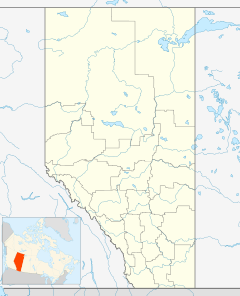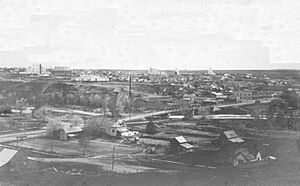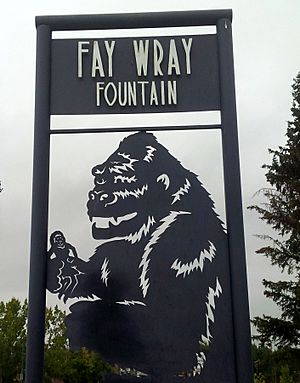Cardston facts for kids
Quick facts for kids
Cardston
|
|
|---|---|
|
Town
|
|
| Town of Cardston | |
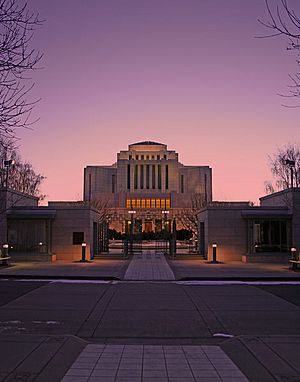
|
|
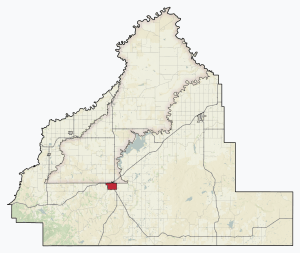
Location in Cardston County
|
|
| Country | Canada |
| Province | Alberta |
| Region | Southern Alberta |
| Planning region | South Saskatchewan |
| Municipal district | Cardston County |
| Incorporated | |
| • Village | December 29, 1898 |
| • Town | June 2, 1901 |
| Area
(2021)
|
|
| • Land | 8.58 km2 (3.31 sq mi) |
| Elevation | 1,130 m (3,710 ft) |
| Population
(2021)
|
|
| • Total | 3,724 |
| • Density | 434.1/km2 (1,124/sq mi) |
| • Municipal census (2018) | 3,909 |
| Time zone | UTC−7 (MST) |
| • Summer (DST) | UTC−6 (MDT) |
| Area code(s) | 403, 587, 825 |
| Highways | |
| Waterway | Lee Creek St. Mary River St Mary Reservoir |
Cardston is a town in Alberta, Canada. It was first settled in 1887 by members of The Church of Jesus Christ of Latter-day Saints (LDS Church). They traveled from Utah to Alberta in one of the last big wagon trips of that century. The town was founded by Charles Ora Card. A building that served as both a church and a school was finished soon after their arrival.
Contents
History of Cardston
For a long time, Cardston was known as a "dry" town, meaning that alcoholic drinks could not be sold there. This rule had been in place for over 100 years! In 2023, after a vote by the residents, the town council decided to allow alcohol to be served in restaurants and places like the local golf course. However, liquor stores, bars, and nightclubs are still not allowed.
In 1951, about 75% of Cardston's 3,500 residents were members of the LDS Church. By 2014, this number was still high, around 80%.
On August 15, 2019, the town was given its own coat of arms by the Canadian Heraldic Authority. This is a special symbol that represents the town.
Geography of Cardston
Cardston is located in the foothills of southwest Alberta. It's about 25 kilometers (15 miles) north of the American state of Montana. To its north, it shares a border with the Kainai Nation (Blood Tribe) Reserve, which is one of the largest reserves in North America. About 40 kilometers (25 miles) west of Cardston, you'll find the Rocky Mountains in Waterton Lakes National Park. Cardston is 77 kilometers (48 miles) southwest of Lethbridge and 234 kilometers (145 miles) south of Calgary.
Cardston's Climate
Cardston has a humid continental climate. Like other parts of southern Alberta, Cardston often experiences "chinooks." These are warm, dry winds that can make winter temperatures rise quickly, sometimes even above 10 degrees Celsius (50 degrees Fahrenheit)! Because of these winds, Cardston has more than 200 windy days each year.
Here are some weather records for Cardston:
- Hottest Temperature: 39.0°C (102.2°F) on July 23, 2007
- Coldest Temperature: -41.7°C (-43.1°F) on January 28, 1929
- Most Rain in One Day: 106.0 mm (4.17 inches) on June 6, 1995
- Most Snow in One Day: 63.5 cm (25.0 inches) on May 4, 1919
- Deepest Snow Cover: 84 cm (33 inches) on April 29, 1967
| Climate data for Cardston, 1981–2010 normals, extremes 1918–present | |||||||||||||
|---|---|---|---|---|---|---|---|---|---|---|---|---|---|
| Month | Jan | Feb | Mar | Apr | May | Jun | Jul | Aug | Sep | Oct | Nov | Dec | Year |
| Record high °C (°F) | 19.0 (66.2) |
21.0 (69.8) |
24.5 (76.1) |
30.5 (86.9) |
33.0 (91.4) |
35.6 (96.1) |
39.0 (102.2) |
36.7 (98.1) |
34.5 (94.1) |
29.5 (85.1) |
23.9 (75.0) |
19.4 (66.9) |
39.0 (102.2) |
| Mean daily maximum °C (°F) | 1.4 (34.5) |
2.5 (36.5) |
5.9 (42.6) |
11.5 (52.7) |
16.5 (61.7) |
20.5 (68.9) |
24.5 (76.1) |
24.8 (76.6) |
19.0 (66.2) |
12.8 (55.0) |
4.5 (40.1) |
1.1 (34.0) |
12.1 (53.8) |
| Daily mean °C (°F) | −4.5 (23.9) |
−3.5 (25.7) |
−0.1 (31.8) |
5.1 (41.2) |
9.9 (49.8) |
13.8 (56.8) |
16.9 (62.4) |
16.9 (62.4) |
11.8 (53.2) |
6.3 (43.3) |
−1.1 (30.0) |
−4.6 (23.7) |
5.6 (42.1) |
| Mean daily minimum °C (°F) | −10.4 (13.3) |
−9.5 (14.9) |
−6.1 (21.0) |
−1.3 (29.7) |
3.3 (37.9) |
7.0 (44.6) |
9.3 (48.7) |
8.9 (48.0) |
4.6 (40.3) |
−0.2 (31.6) |
−6.7 (19.9) |
−10.3 (13.5) |
−1 (30) |
| Record low °C (°F) | −41.7 (−43.1) |
−38.9 (−38.0) |
−36.7 (−34.1) |
−25.6 (−14.1) |
−12.8 (9.0) |
−5.6 (21.9) |
−0.5 (31.1) |
−3.9 (25.0) |
−15.6 (3.9) |
−26.5 (−15.7) |
−35.6 (−32.1) |
−38.5 (−37.3) |
−41.7 (−43.1) |
| Average precipitation mm (inches) | 20.8 (0.82) |
19.1 (0.75) |
37.5 (1.48) |
40.6 (1.60) |
81.3 (3.20) |
90.7 (3.57) |
45.5 (1.79) |
43.9 (1.73) |
53.1 (2.09) |
31.6 (1.24) |
29.6 (1.17) |
21.5 (0.85) |
515.0 (20.28) |
| Average rainfall mm (inches) | 0.4 (0.02) |
0.0 (0.0) |
1.5 (0.06) |
10.8 (0.43) |
66.7 (2.63) |
90.7 (3.57) |
45.5 (1.79) |
43.7 (1.72) |
49.2 (1.94) |
9.9 (0.39) |
2.1 (0.08) |
0.1 (0.00) |
320.6 (12.62) |
| Average snowfall cm (inches) | 20.4 (8.0) |
19.1 (7.5) |
36.0 (14.2) |
29.7 (11.7) |
14.6 (5.7) |
0.0 (0.0) |
0.0 (0.0) |
0.1 (0.0) |
3.6 (1.4) |
21.7 (8.5) |
27.4 (10.8) |
21.4 (8.4) |
194.2 (76.5) |
| Source: Environment Canada | |||||||||||||
Cardston's Population
In 2021, the Town of Cardston had a population of 3,724 people. These residents lived in 1,261 homes. This was a small increase from its population of 3,585 in 2016. The town covers an area of 8.58 square kilometers (3.31 square miles).
In 2016, Cardston's population was 3,585 people. This was very similar to its population of 3,580 in 2011.
| Age | Male | Female | Total |
|---|---|---|---|
| 0–4 | 115 | 140 | 255 |
| 5–14 | 335 | 310 | 645 |
| 15–19 | 175 | 180 | 355 |
| 20–24 | 105 | 100 | 205 |
| 25–34 | 125 | 160 | 285 |
| 35–44 | 175 | 210 | 385 |
| 45–54 | 165 | 200 | 365 |
| 55–64 | 125 | 155 | 280 |
| 65–74 | 135 | 170 | 305 |
| 75+ | 150 | 260 | 410 |
| Totals | 1600 | 1870 | 3470 |
Source: Statistics Canada 2001 Census (numbers may not add up due to rounding)
Cardston's Economy
The main ways people make a living in Cardston are through education, health care, starting their own businesses, farming, and tourism. Cardston is one of the few places in Canada where alcohol cannot be sold or bought in most places. The Cardston Airport is located southeast of the town.
Fun Things to Do in Cardston
Cardston has many places for sports and recreation. You can find a soccer park, ball parks, a golf course, an ice skating rink, a swimming pool, tennis courts, hiking trails, and a skateboard park. There's also a hockey stadium, several recreation parks, picnic areas, and playgrounds. In the summer, you can enjoy water sports at the St. Mary's Dam reservoir, which is northeast of Cardston.
The Cardston Alberta Temple was built by early settlers from 1913 to 1923. It was the first temple built by the Latter-day Saint Church outside of the United States. It was the only temple in Canada until the Toronto Ontario Temple was built in 1990.
The Remington Carriage Museum has the largest collection of horse-drawn vehicles in North America. It has over 250 carriages, wagons, and sleighs! This large museum has video displays, a fire hall, a carriage factory, and a workshop where old carriages are fixed. You can also enjoy carriage rides, rent carriages, visit a working stable, eat at a restaurant, and buy gifts. Guided tours are available too.
The Carriage House Theatre was built in 1912. It has been updated several times and can seat 350 people. It shows movies and hosts local plays, as well as professional summer theater shows.
The Card Pioneer Home was built in 1887 by Charles Ora Card, the town's founder. It was used as a community center and a place for travelers to stop before the first hotel was built. This old log building is still in its original spot and you can visit it. It's a registered historic site in Alberta.
The Courthouse Museum is a building made of sandstone, built in 1907. The stone came from a quarry near Cardston. This building was used as a courthouse longer than any other in Alberta. Inside, you can see the judge's bench, the witness box, and even the old jail cells. It is also a registered historic site.
Education in Cardston
The schools in Cardston are part of the Westwind School Division. These include Cardston High School, Cardston Jr. High School (which used to be Eastridge Elementary School), and Cardston Elementary School.
Some older schools like Leeside and Westside are no longer around. The buildings for E.J. Wood School, Parkland School, and John S. Smith Schools were taken down in 1993 when the junior high moved to the Eastridge building. Cardston High School had big renovations in the early 2000s. It got a bigger gym, better fitness and weight rooms, wider hallways, and a new cafeteria.
Cardston in the Media
The Cardston News newspaper first started in 1924 and was published every week for a short time. It was managed by different people over the years. Another newspaper, the Cardston Record, began publishing weekly in 1898.
Famous People from Cardston
Many notable people have connections to Cardston:
- Victor L. Brown - A leader in the LDS Church.
- Ben Cahoon - A professional football player who won three Grey Cup championships with the Montreal Alouettes.
- Grant Hunter - A politician who serves as an MLA for Taber-Warner.
- Elaine L. Jack - A leader in the LDS Church.
- Merlin R. Lybbert - A leader in the LDS Church.
- Shawna Molcak - A basketball player who played for Canada in the 1996 Summer Olympics.
- Grant Strate - A famous dancer and choreographer.
- Elle-Máijá Tailfeathers - A filmmaker, actor, and producer with Blackfoot and Sámi heritage, born in Cardston.
- Frank Weiss - A racing car driver.
- Edward J. Wood - A leader in the LDS Church.
- George Woolf - A well-known jockey.
- Fay Wray - A famous actress, best known for her role in the 1933 film King Kong.


